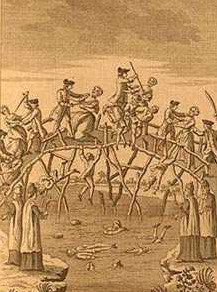The 1641 Rebellion




The 1641 Rebellion broke out in Ulster on 22 October and was marked by attacks on the English and Scottish Protestant settlers who had arrived in Ulster in the Ulster Plantation. The Gaelic Irish of the province, led by Sir Phelim O'Neill captured a string of defensive towns in county Armagh. This was the beginning of a period of chaos which would last around eight months until the formation of the Confederation of Kilkenny in the later months of 1642.
At first, there were beatings and robbing of local settlers, then house burnings and expulsions and finally killings. By November 1641, armed parties of Ulstermen were rounding up British Protestant settlers and marching them to the coast, from which they were forced to board ships to Britain. Over the first four months the rebellion spread from Ulster to the southern provinces. By November the rebellion had reached Wexford and, as in the rest of Ireland soon affected all people in the region. Landowners and the gentry were most afflicted by the events of this rebellion as the social order collapsed into a state of confusion and violence.
Massacre at the Bann Bridge
 A group of Protestants were imprisoned in a church in Loughall. They had been informed that they were going to be marched eastwards where they were to be expelled to England. The Irish soldiers were said to be led by either Captain Manus O'Cane or Toole McCann, later accounts of the event differed on this point. After some time, the English civilians were taken out of the Church and marched to a bridge over the river Bann. Once on the bridge, the group was stopped. At this point the civilians, threatened by pikes and swords, were forcibly stripped of their clothes. They were then herded off the bridge into the icy cold river waters at swordpoint. Most drowned or died of exposure, although some were said to have been shot by musket fire as they struggled to stay afloat.
Estimates of the number of those killed varied from less than 100 to over 300. William Clark, a survivor of the massacre, said during the 1642 depositions that as many as 100 were killed at the bridge. As Clark was a witness of the massacre his figure is taken as being the most credible. A group of Protestants were imprisoned in a church in Loughall. They had been informed that they were going to be marched eastwards where they were to be expelled to England. The Irish soldiers were said to be led by either Captain Manus O'Cane or Toole McCann, later accounts of the event differed on this point. After some time, the English civilians were taken out of the Church and marched to a bridge over the river Bann. Once on the bridge, the group was stopped. At this point the civilians, threatened by pikes and swords, were forcibly stripped of their clothes. They were then herded off the bridge into the icy cold river waters at swordpoint. Most drowned or died of exposure, although some were said to have been shot by musket fire as they struggled to stay afloat.
Estimates of the number of those killed varied from less than 100 to over 300. William Clark, a survivor of the massacre, said during the 1642 depositions that as many as 100 were killed at the bridge. As Clark was a witness of the massacre his figure is taken as being the most credible.
The total of Protestant civilians killed in Ulster in the early months of the rebellion was about 4,000. In County Armagh, recent research has shown that about 1,250 Protestants were killed or about a quarter of the planter population there. The Portadown massacre was used to support the view that the Irish Uprising was a papal conspiracy to massacre all of the Protestant inhabitants of Ireland, though in truth large scale massacres such as this were mostly confined to Ulster. The atrocity featured prominently in Parliamentarian propaganda works in the 1640s, most famously by John Temple's The Irish Rebellion of 1646. The immediate goal of these propagandists was to isolate King Charles, who many prominent English Protestants such as John Pym viewed as being sympathetic to Irish Catholics.
Towards the end of 1641, the village of BallyLurgan was attacked. In October of the same year Brownlow was warned that the village would be attacked and its inhabitants killed. The English from the village assembled those from the rural areas outside Lurgan and lodged then in Brownlow's bawn.
When the village was attacked by the Irish, it was led by two members of the Magennis family. The bawn was surrounded and the Irish offered safe release of the landlord and his followers and assured that they would have safe passage to Lisnagarvey (Lisburn).
When the castle gates where opened the terms of the agreement did not come to pass and in the ensuing battle many Englishmen were killed. Some were stripped and injured. William Brownlow, his wife and family were taken prisoner and brought to Armagh and then to Dungannon, in County Tyrone.
The land was then passed to the McCanns, and also the O'Hanlons.
In 1642 Brownlow and his family were released by the forces of Lord Conway, who was operating in the Dungannon area.
In the longer term, accounts of the Portadown massacre strengthened the resolve of many Parliamentarians to launch a reconquest of Ireland, which they did in 1649. John Temple's inflammatory work was published at least ten times between 1646 and 1812 the graphic massacres depicted therein were frequently used as a justification for the sectarian Penal Laws then in Ireland.


| 
